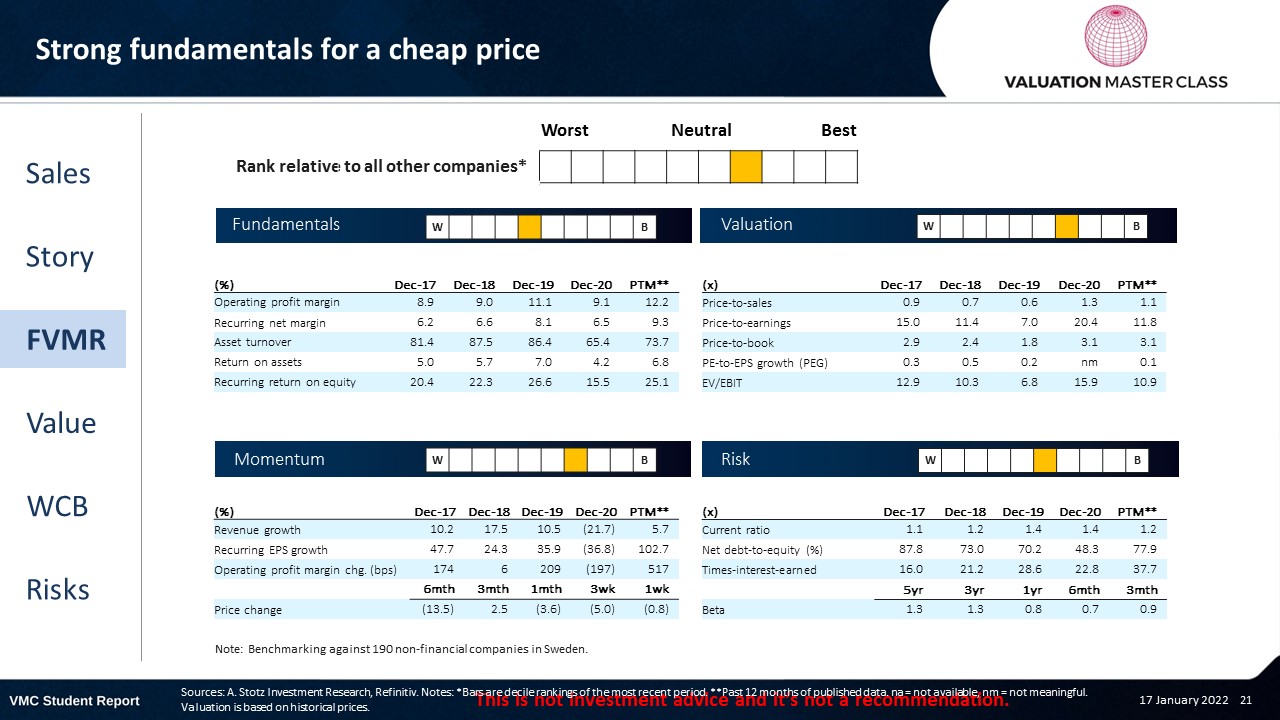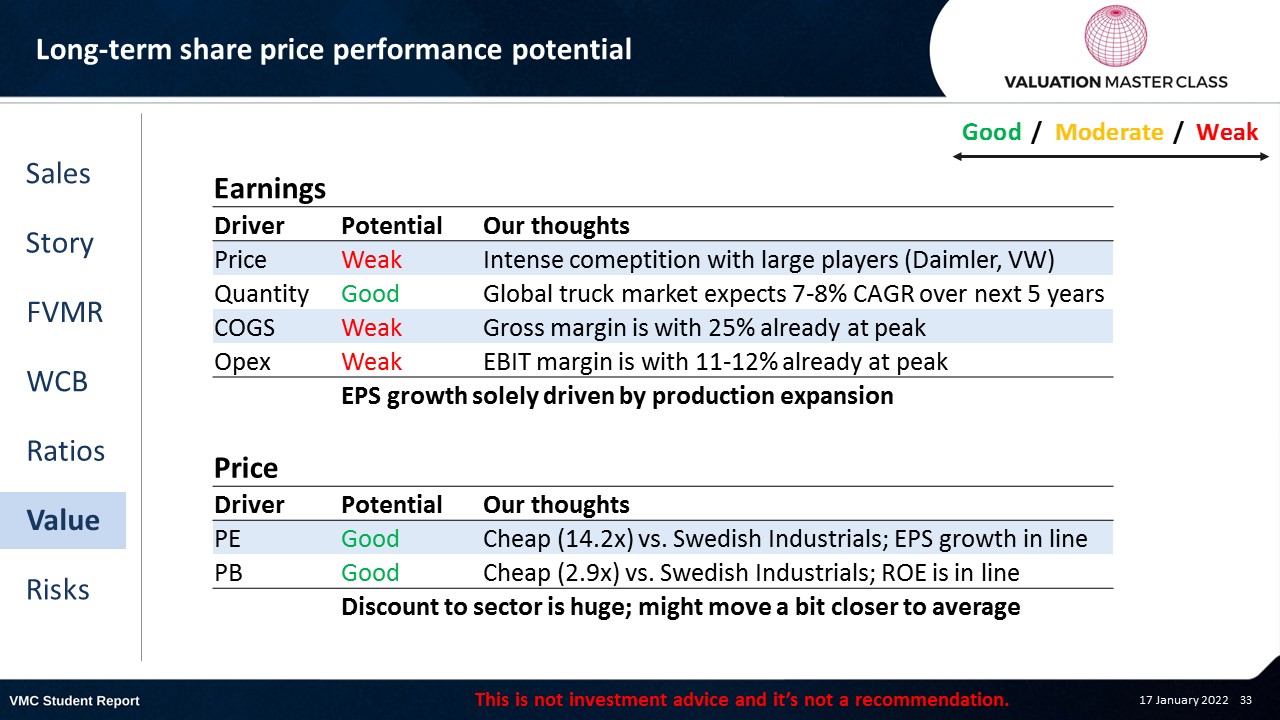- Value play with strong dividend growth potential
- Price on the way to turn bullish, volume signal unclear
- Volvo’s revenue breakdown 9M21
- Acquisition in China to ride demand wave
- New production site adds 7% capacity
- Consistent value addition through strong profitability
- What happens to a company’s ROIC over time?
- Leading role in EV and hydrogen to reclaim market share
- FVMR Scorecard – Volvo
- Consensus remains cautious but sees upside
- Long-term share price performance potential
- World Class Benchmarking Scorecard – Volvo
- Key risk is intensified competition in local markets
- Conclusions
Value play with strong dividend growth potential
The post was originally published here.
Highlights:
- Acquisition in China to ride demand wave
- Consistent value addition through strong profitability
- Leading role in EV and hydrogen to reclaim market share

Download the full report as a PDF
Price on the way to turn bullish, volume signal unclear

- In 2H21, the 50 DMA has mainly stayed below the 200 DMA
- However, most recently, the 50 DMA started to rise, and it seems like it can cross the 200DMA very soon
- If the 50 DMA-line were to continue to rise, we would consider it a bullish signal
- The RSI-Volume recently converged to the 50%-line which, if continues, would also be a positive sign
Q1 2022 hedge fund letters, conferences and more
Volvo’s revenue breakdown 9M21

Acquisition in China to ride demand wave

- China is by far the strongest and fastest-growing market for heavy duty trucks in the world
- It is the primary market for the company to realize future growth opportunities
- Instead of exporting to China, Volvo aims to ramp up sales by establishing a production site in the country
New production site adds 7% capacity
- Volvo confirmed its plan to acquire JMC Heavy Duty Vehicle which owns a manufacturing site in Taiyuan, China
- The acquisition accumulates to SEK1.1bn
- With the acquisition, Volvo aims to ramp up its sales in China
- It adds 15,000 trucks to Volvo’s capacity
- As a comparison, in 2020, Volvo delivered 4,500 trucks to China
Consistent value addition through strong profitability

- Volvo’s impressive ROIC is attributable to its specialization in high-margin trucks and construction equipment
- Volvo sold its passenger vehicles unit in 1999 as the synergies between commercial and passenger vehicles were low
- Since 2021, Volvo Car is a separate listed entity under majority control of Geely
- Volvo’s biggest competitor Daimler followed a similar strategy by spinning-off its truck segment in January 2022
What happens to a company’s ROIC over time?

Leading role in EV and hydrogen to reclaim market share

- Over the past 5 years, Volvo has lost market share in its most important regions
- Still, its early shift toward pure EV vehicles could help to regain its market share over the long run
- The company is also betting on hydrogen which could be more suitable for trucks due to its long-distance ability
- Strategic partnerships with Daimler (largest truck manufacturer) could lead to a more concentrated industry
FVMR Scorecard – Volvo
- A stock’s attractiveness relative to stocks in that country or region
- Attractiveness is based on four elements
- Fundamentals, Valuation, Momentum, and Risk (FVMR)
- Scale from 1 (Best) to 10 (Worst)

Consensus remains cautious but sees upside
- 17 analysts expect the company to outperform while 9 analysts still stay cautious
- Analysts expect strong revenue growth in the next two years, but might be too pessimistic in 23E
- Given that the global truck segment is expected to grow by 7-8% until 25E, I believe that Volvo can maintain a growth rate above 5%
Get financial statements and assumptions in the full report
P&L – Volvo
- Net profit sees a strong rebound in 21E and could exceed its pre-pandemic level in 22E
- The strong bottom-line is mainly driven by the margin expansion, but also strong growth prospects
Balance sheet – Volvo
- Net assets have fallen in 2020 after selling UD truck segment to Isuzu Motors
- However, increased CAPEX for capacity expansion and battery development lead to increase in net fixed assets again
- The company is moderately leveraged
- In 2020, its net-debt to equity ratio stood at 0.9x
Cash flow statement – Volvo
- Strong operating cash flow allows the company to resume its dividend payments in line with its pre-pandemic policy
- I expect dividend yield over the near-term to range between 2.5-3.5%
Ratios – Volvo
- After the revenue rebound in 22E, we assume revenue growth to normalize
- Beyond 2022, I see a healthy annual revenue growth potential around 5%
- EBIT margin expansion in 21E likely to stay
- This helps Volvo to be among the most profitable trucks manufacturer
Long-term share price performance potential

Free cash flow – Volvo
- Strong cash flow generation is crucial for returning dividends to shareholders
Value estimate – Volvo
- I see a slightly higher revenue growth than consensus
- Tapping further into the Chinese market could constitute a catalyst for the share price
- Truck market has favorable growth prospects

World Class Benchmarking Scorecard – Volvo
- Identifies a company’s competitive position relative to global peers
- Combined, composite rank of profitability and growth, called “Profitable Growth”
- Scale from 1 (Best) to 10 (Worst)

Key risk is intensified competition in local markets
- Adverse regulatory environment in China could hamper business
- Underestimating smaller local competitors could make expansion difficult
- Failure to keep up with technological shift to long-distance EV vehicles
Conclusions
- Riding demand wave in China is biggest potential for growth
- Fast adaption to EV and hydrogen give it a timing advantage in the market
- Industry-leading ROIC, but still trading at a discount
Download the full report as a PDF
Article by Andrew Stotz, Become a Better Investor.

